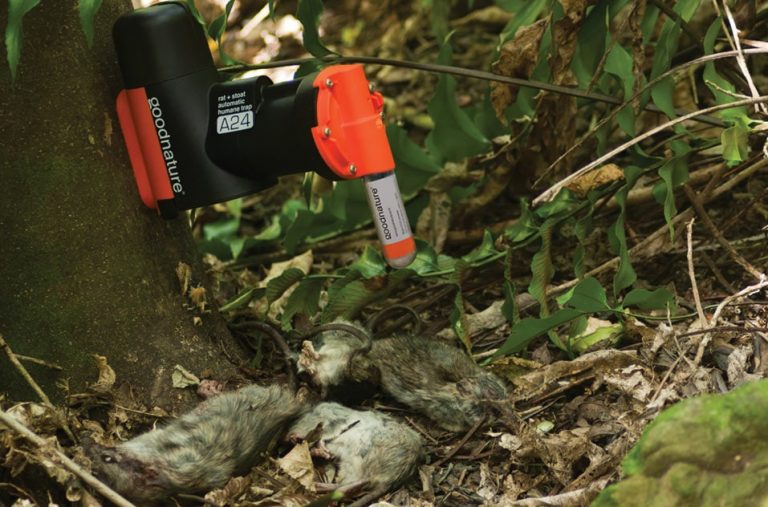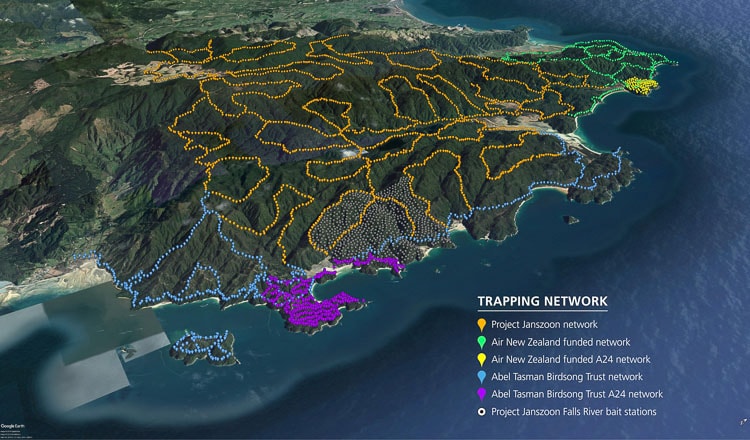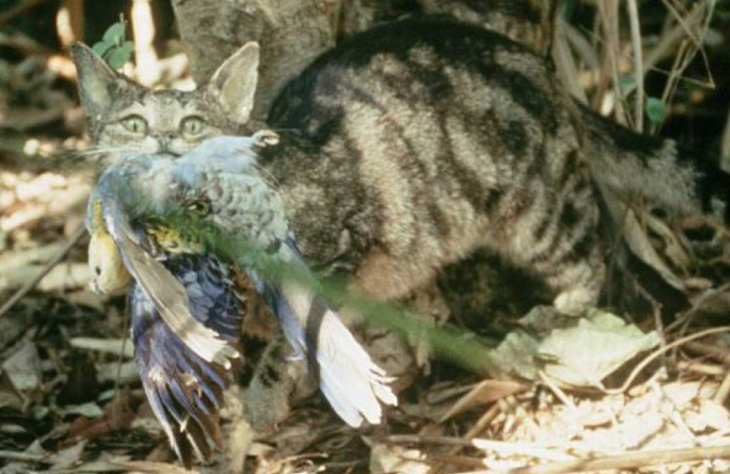PREDATOR CONTROL
PREDATOR CONTROL WILDING PINES WASP CONTROL WEED CONTROL
It is estimated introduced predators kill 68 thousand native birds in New Zealand every day.
In the Abel Tasman, we want to give native birds and plants a chance to thrive.
The Abel Tasman Baddies
We’re focusing our pest control efforts on the park’s top three introduced predators–rats, stoats and possums–to allow the forest canopy to recover and reduce attacks on chicks and nesting birds so they can rebuild their populations.

Rats
Rats can attack birds and chicks nesting high in trees. They also eat native wetā, snails, insects and lizards.

Stoats
Stoats are the major cause of the decline of species like kākā, kākāriki/yellow crowned parakeet.

Possums
Possums consume an estimated 21,000 tonnes of vegetation in New Zealand forests every night. In the Abel Tasman they can severely damage large areas of natives like rata, totara, titoki and mistletoe. They also prey on bird eggs and young chicks.

RAT TRAPPING
We are working to provide a safe corridor for native birds from the high altitudes to move down to the coastal areas of the park. This is achieved using a combination of trapping using A24 self-resetting traps around the coast, coupled with aerial predator control when rat numbers soar in the interior.
Self re-setting rat traps
The Abel Tasman Birdsong Trust runs an intensive network of A24 self-resetting Goodnature traps between Pitt Head and Bark Bay to provide a safe environment for birds to re-establish and disperse in areas of high public use.
The traps are powered by a CO2 gas canister that can kill up to 24 times per canister. Volunteers check the traps regularly.

STOAT TRAPPING
Nearly 95% of the Park is now stoat-trapped – a collaboration between Project Janszoon, DOC, the Abel Tasman Birdsong Trust and Air New Zealand.
The majority of traps are DOC 200 traps, but there are five different types of trap boxes in use, some using single traps, others double. We are constantly reviewing how the different trap boxes and different lures perform.
DOC rangers and volunteers from the Abel Tasman Birdsong Trust check and reset the traps every month. It is hard work and they do a great job – they remove and record kills, and add fresh bait.
The stoat lines are positioned 1 km apart with traps set at 100m intervals along the tracks. At this density the network meets best practice standards for stoats, but it is not dense enough for effective rat control.
AERIAL PREDATOR CONTROL
During a beech mast, when rat numbers soar because of plentiful food, or when possum numbers grow, aerial predator control is the most effective way to control introduced predators.
Given the large area and difficult terrain, aerially applied cereal baits containing biodegradable 1080 pesticide, is sown by helicopter.
1080 is the common name for sodium fluoroacetate, a synthetic version of a naturally occurring toxin found in a range of plants from South America, Africa and Australia. A 2011 Parliamentary Commissioner for the Environment report into the use of 1080 found it was the most effective tool currently available to protect our native wildlife.
In the winter of 2020 an aerial pest control operation took place to control high rat numbers.
High numbers of rats can overwhelm the extensive trapping networks operating in the park. This focused aerial pest control operation in the upper reaches of the park has helped to protect a higher-elevation area that is a stronghold for native wildlife, enabling us to safely release native birds like whio which are highly susceptible to predators.
For more information on the 2020 aerial predator control operation click here
Click here to read the Parliamentary Commissioner for the Environment report on 1080 use.

feral cat control
Feral cats are a major threat to nesting birds like pāteke / brown teal and whio / blue duck in the Abel Tasman, as well as lizards, wētā and other insects.
A feral cat lives in the wild and has little or no human contact. They can have similar colourations to some common, short-haired house cats such as tabby, tortoiseshell or black. But when conditions are favourable they can grow to a much larger size, though they don’t live as long. They can travel long distances. Scientists tracked a feral cat in the South Island high country that covered almost six kilometres in one night.
Feral cats are hard to control as they are intelligent animals. While trapping has been underway at Hadfield Clearing, near the Awaroa inlet since 2015, there has been limited success.
In 2018, we also trialled bait stations baited with PAPP (PredaSTOP for Feral Cats). PAPP was developed specifically for feral cat and stoat control and is seen as an efficient and humane toxin. However, with low interactions the trial was halted the same year
TRAPPINGS TO DATE







